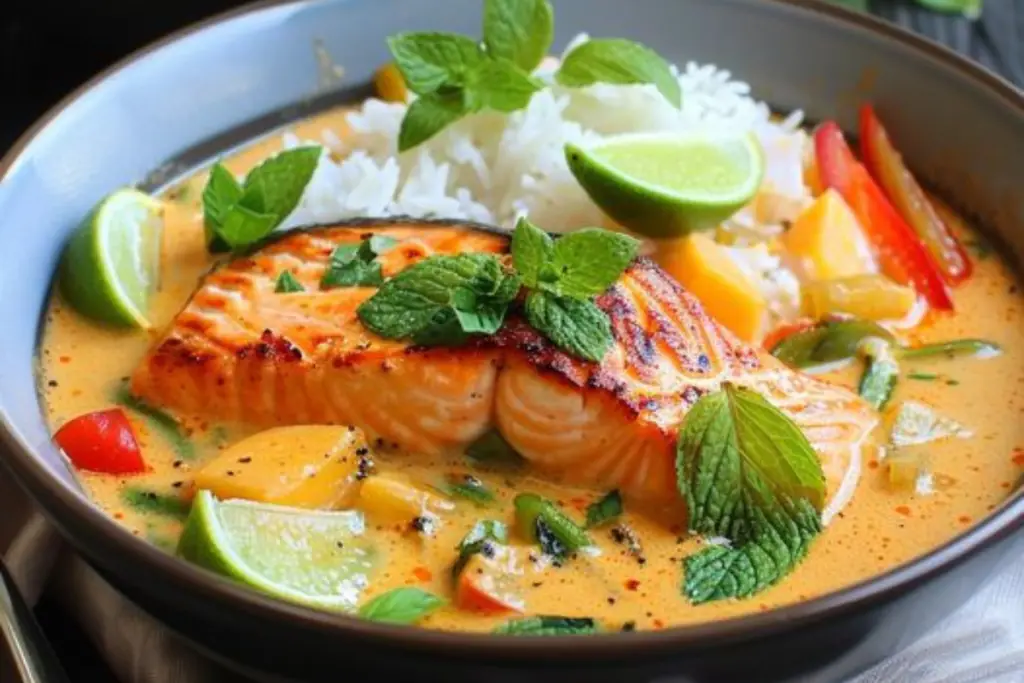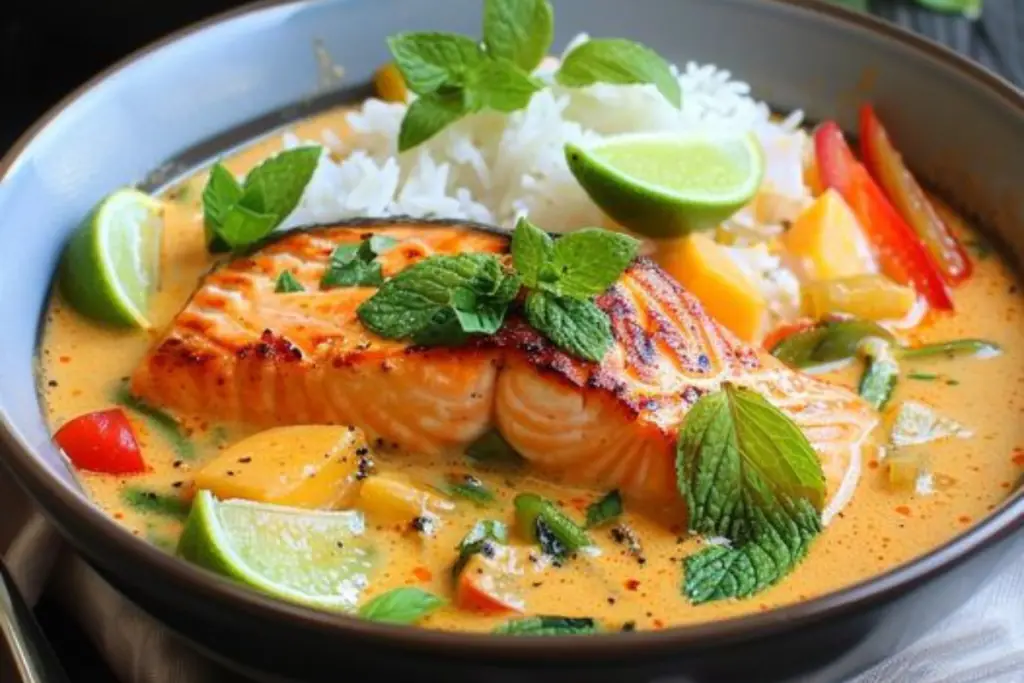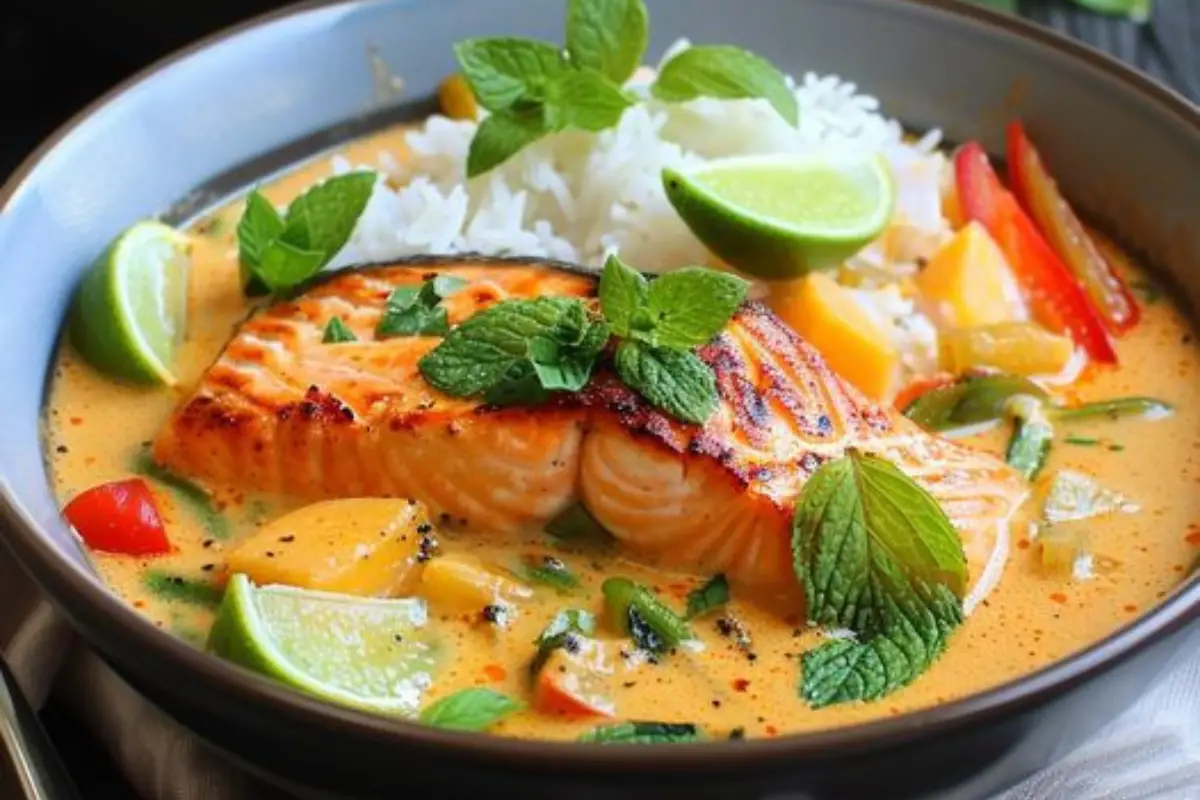Introduction: Why Thai Coconut Salmon Curry?
Ever wondered what happens when the rich, creamy texture of coconut milk collides with the robust zest of Thai spices and the succulent, pink flesh of salmon? The answer is Thai Coconut Salmon Curry—a dish that not only warms your belly but also captivates your palate with its delightful complexity and depth of flavors.
What Is Thai Coconut Salmon Curry?
Imagine a dish that perfectly encapsulates the essence of Thai cooking—coconut salmon curry is just that. It’s a harmonious blend of aromatic Thai spices, creamy coconut milk, and rich, omega-3 packed salmon, simmered to perfection. This dish offers a culinary passport to the vibrant streets of Bangkok without leaving your kitchen.
The Origins of Thai Coconut Curry
The Roots in Thai Cuisine
Thai cuisine is famed for its ability to balance the five fundamental flavors: sweet, salty, sour, bitter, and umami. Originating from the royal kitchens of Thailand, coconut curry was traditionally a complex and elegant dish that showcased this balance beautifully.
The Evolution into Salmon Curry
While not originally made with salmon, the adaptation of this curry with salmon fillets has become a modern favorite, particularly in the West. The rich oils of the salmon add a luxurious depth to the curry that is hard to resist.

The Ingredients: What You’ll Need
1)4 salmon fillets skin removed
2)1 red bell pepper finely chopped
3)1 baby bok choy roughly chopped
4)2 tbsp coconut oil or vegetable oil
5)1 tbsp unsalted butter
6)1 small onion finely chopped
7)4 garlic cloves minced
8)1 tbsp grated ginger
9)1 ¾ cups unsweetened coconut milk full fat
10)½ cup vegetable broth
11)3 tbsp Thai red curry paste
12)2 tbsp tomato paste
13)1 tbsp peanut butter
14)2 tbsp lemon juice
15)1 tbsp fish sauce
16)salt
17)black pepper
18)½ tsp ground coriander
19)½ tsp ground cumin
20)½ tsp sweet paprika
21)1 tsp red pepper flakes
22)basil leaves
23)steamed Jasmine rice or flatbread for serving
INSTRUCTIONS
Pat the salmon fillets dry with a paper towel and season all over with salt, pepper and sweet paprika.
Heat coconut oil and butter in a large non-stick frying pan over medium high heat. Add the salmon fillets and sear, about 3-4 minutes on each side. Remove from the pan and set aside
In the same pan, add onion, garlic and ginger. Cook for 2 minutes over low heat until fragrant. Add bell pepper, cook for 3 minutes, stirring occasionally. Stir in tomato paste and curry paste, cook for 1 minute. Add coriander, cumin and red pepper flakes. Season with salt and pepper. Pour broth and bring to a boil.
Add bok choy, fish sauce and peanut butter. Stir to combine. Pour coconut milk and bring to a simmer.
Nestle salmon in the sauce. Sprinkle with lemon juice and simmer for 3-5 more minutes or until the salmon is just cooked through and the sauce is slightly thickened. Remove from heat.
Stir in the basil leaves and serve with rice or some crusty bread. Top with extra red pepper flakes. Enjoy!
Tips for the Perfect Curry
Choosing the Right Curry Paste
Opt for high-quality Thai curry paste, either red or green, depending on your heat preference. The paste is pivotal in achieving the authentic Thai flavor.
Balancing the Flavors
Taste as you go and adjust the seasoning with fish sauce for saltiness, sugar for sweetness, and lime juice for acidity to achieve that perfect Thai flavor balance.

Serving Suggestions
Accompaniments
Serve your Thai coconut salmon curry over a bed of jasmine rice or with rice noodles for a fulfilling meal.
Garnishes
A handful of fresh basil leaves, cilantro, and a few wedges of lime not only add color but enhance the flavors with their freshness.
Health Benefits of Thai Coconut Salmon Curry
Rich in Omega-3
Salmon is a fantastic source of Omega-3 fatty acids, which are crucial for heart health and brain function.
Antioxidant Properties
The spices and herbs used in Thai cooking are known for their anti-inflammatory properties and antioxidants, making this dish not only delicious but also beneficial for your health.
Cultural Significance of Thai Curries
A Dish of Celebration
In Thailand, curry is more than just a meal; it’s a celebration of culture and tradition, often enjoyed during festivals and family gatherings.
A Symbol of Hospitality
Serving curry is considered a gesture of hospitality and respect towards guests, reflecting the Thai ethos of warmth and generosity.
FAQs About Thai Coconut Salmon Curry
Can I use frozen salmon?
Yes, frozen salmon works fine, just make sure it’s fully thawed and patted dry to avoid wateriness in the curry.
What if I can’t find kaffir lime leaves?
While kaffir lime leaves add a unique flavor, you can substitute with a bit of lime zest and bay leaves for a similar fragrant note.
Conclusion:
a mere meal; it’s a vibrant journey into the heart of Thai cuisine that invites both your senses and spirit on an adventure. This dish exemplifies how food can be both nourishing and a profound expression of cultural identity, marrying the robust flavors of the East with the rich textures of the West. So, why not make this recipe a new favorite in your culinary repertoire? Each bite is not just a testament to the exquisite complexity of Thai flavors, but also a delightful encounter with the unexpected.
By embracing the process of preparing Thai Coconut Salmon Curry, you engage in a ritual that is steeped in history and flavor. Whether it’s a quiet dinner for one, a meal with family, or a larger gathering of friends, this dish is designed to bring people together, offering a taste of Thai hospitality and warmth.
So go ahead, give this recipe a try, and let each spoonful transport you to the bustling markets of Bangkok, where food is celebrated, savored, and shared. It’s more than just cooking; it’s an experience, a way of connecting to the world, and a chance to bring a piece of Thai culture into your own kitchen.

